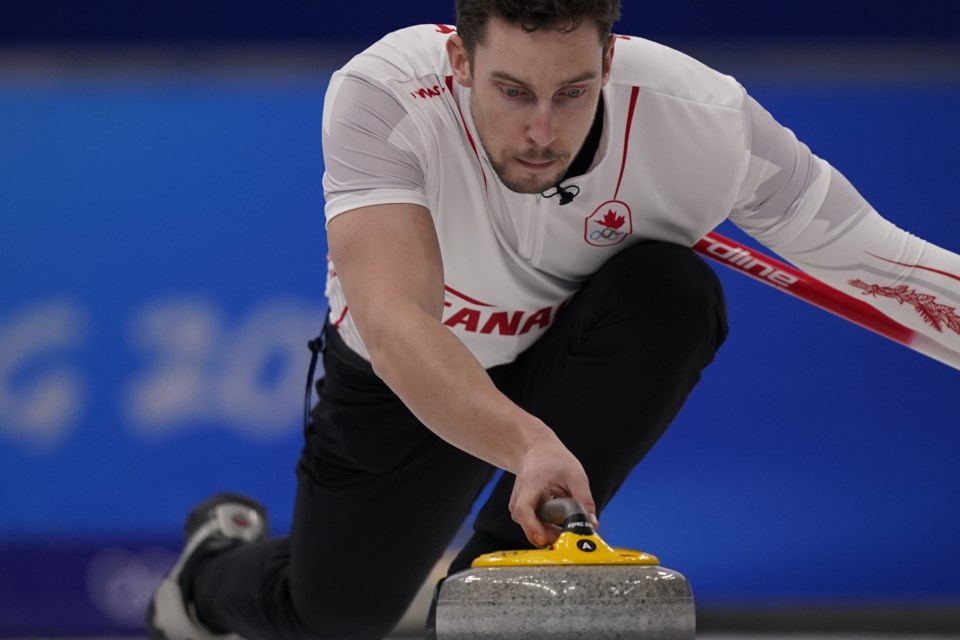BEIJING ŌĆö The members of the Canadian women's curling team huddled in the far corner of the Ice Cube on Thursday for a long half-hour wait to learn their Olympic fate.
They had done their part by beating Denmark 10-4 but needed help from other teams to make the playoff cut.┬Ā
Occasional glances at the game action on the large video screen were like regular body blows. Sweden finally delivered the knockout punch by defeating South Korea.┬Ā
A 5-4 record left Jennifer Jones in a three-way tie but short of the four-team cut.┬Ā
"It just wasn't enough," she said. "The sadness is more that it's over. We don't get to play anymore and that always makes me sad."
In the evening, sa╣·╝╩┤½├Į's Brad Gushue dropped a 5-3 semifinal decision to Sweden's Niklas Edin. Gushue tried a runback double-takeout for the win but instead gave up a steal for the loss.
"I liked our chances of winning in our own hands," Gushue said. "We took the chance and just missed."
Britain's Bruce Mouat beat American John Shuster 8-4 in the other semifinal.┬Ā
Gushue will play Shuster for bronze on Friday and Mouat and Edin will meet for gold on Saturday.┬Ā
Jones, meanwhile, an Olympic champion in 2014, fought back after a slow 1-3 start.
She displayed flashes of top form at times but blowing a late lead against China on Wednesday night proved costly.┬Ā
Britain and Japan joined sa╣·╝╩┤½├Į at 5-4 and all had 1-1 records against the other.┬Ā
That left pre-game draw shot challenge numbers as the tiebreaker and Jones was last in the 10-team field.
Tiebreaker games are used at top Canadian curling events. But the World Curling Federation uses head-to-head records and last stone draw numbers.
"I've always enjoyed the tiebreaker games," said sa╣·╝╩┤½├Į vice Kaitlyn Lawes. "I don't think games should be decided based on one shot.┬Ā
"Unfortunately we struggled with that this week. It's just the way it is."
There were 16 possible seeding scenarios entering the last round-robin draw. Only two of them involved draw shot challenge numbers.┬Ā
After the Canadians and Danes shook hands after eight ends, Switzerland's Silvana Tirinzoni topped Japan's Satsuki Fujisawa 8-4.
A few minutes later, Britain's Eve Muirhead beat Russia's Alina Kovaleva 9-4. That left sa╣·╝╩┤½├Į needing a South Korean comeback win over Sweden.
"Honestly, I couldn't watch," Lawes said. "It's difficult when it's out of our control."
EunJung Kim was down two with hammer in the 10th end but missed a double-takeout attempt to give Anna Hasselborg a steal and an 8-4 win.┬Ā
The dejection was evident as Jones, Lawes, second Jocelyn Peterman, lead Dawn McEwen and alternate Lisa Weagle picked up their gear and left the ice area.┬Ā
"The only thing with a tiebreaker, at least you get to play for it," said coach Viktor Kjell. "But at the same time, we had nine chances to do a good draw shot here and we didn't execute on that."
The system has its detractors. But victories make it a non-issue and the wins simply didn't come often enough for sa╣·╝╩┤½├Į this week.┬Ā
The team turned in a middling performance and Jones shot just 74.4 per cent overall, ranking her eighth out of 10 skips. ┬Ā┬Ā
Switzerland took the first seed at 8-1 and will meet Japan on Friday. Sweden (7-2) will play Britain in the other semifinal.
Britain was eighth out of 10 teams (35.27 cm) on pre-game throws -- also called last stone draw -- while Japan was ninth (36.00).┬Ā
sa╣·╝╩┤½├Į (45.44) was well back in 10th place.
National team manager Elaine Dagg-Jackson said the rink had posted strong DSC numbers all season and regularly practised the shots at a pre-Games training camp.
"When we came out here, the rocks just didn't go to the right spot," she said. "Certainly there'll be a debrief about that.
"But it was mysterious because it was something they felt very confident about coming in here."
During the draw shot challenge, each team throws two stones to the button.┬Ā
The rock's distance from the pin is measured and the team with the best results opens with hammer.
For tiebreaker purposes, each team's numbers from all nine round-robin games are averaged with the two worst throws taken away.
"We don't want our Olympic dream to be dashed because of a draw shot," said Japanese coach J.D. Lind. "So as much as I don't think it's the best, we all know that it could eliminate you."
The Canadian women haven't reached the Olympic podium since Jones ran the table eight years ago in Sochi, Russia.┬Ā
"I'm feeling proud yet incredibly sad," Jones said.
sa╣·╝╩┤½├Į's mixed doubles team of Rachel Homan and John Morris also missed the playoffs.┬Ā
Gushue, the 2006 Olympic champion, still has a shot at returning to the podium after a tough two-loss day.┬Ā
As expected, it was a tight defensive battle against Edin. Gushue felt he had a better chance of making his final shot in the 10th rather than getting a steal in the extra end.
"It was an extremely difficult shot and we literally missed it by a whisker," Gushue said. "It's less than a millimetre on the top rock."
In the morning draw, Gushue closed out his round-robin schedule with a 5-2 loss to Mouat. Both teams had already qualified for the playoffs.
This report by The Canadian Press was first published Feb. 17, 2022.
Follow @GregoryStrongCP on Twitter.
Gregory Strong, The Canadian Press

